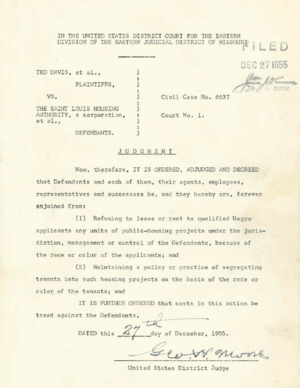Davis et al. v. The St. Louis Housing Authority facts for kids
Davis et al. v. The St. Louis Housing Authority was an important court case from 1952. It happened in Saint Louis, Missouri. This lawsuit challenged unfair rules that kept Black families from renting public housing. The court decided that the St. Louis Housing Authority could not refuse to rent homes to qualified African Americans because of their race. The case was heard in a special federal court in Missouri.
Contents
Public Housing Before Davis
The St. Louis Housing Authority is a group in St. Louis, Missouri. It helps provide public housing. The U.S. government, through the U.S. Department of Housing and Urban Development (HUD), gives money to this Authority. Its job is to rent homes to people who qualify.
Before the Davis case, the Authority had a policy. It kept public housing separate for white and Black residents. For example, the court in Davis found that the Clinton Peabody Terrace and John J. Cochran Project were only for white residents. Also, the Carr Square Village homes were only for Black residents.
In the early 1950s, there were not enough homes for Black residents. So, some Black families tried to apply for homes in buildings meant for white residents. The court found that these families "desperately needed good, safe, and clean housing." The St. Louis Housing Authority often turned away Black applicants. This happened even when the only available homes were in buildings set aside for white people.
The Davis Decision
In the Davis case, Federal Judge Moore made a big decision. He said that the St. Louis Housing Authority's policy of separating people by race was against the law. It was unconstitutional.
Judge Moore's order permanently stopped the Authority. It could no longer treat people differently based on their race when they applied for housing. Also, the Authority was not allowed to keep policies that separated people by race in their housing.
What Davis Changed
The Davis case is one of the important cases that helped end racial separation in public places. It also helped end the idea of "separate but equal" in the United States. This idea said that if things were separate for different races, they were okay as long as they were equal. But often, they were not equal.
A law professor named Joseph B. Robison wrote about this in 1961. He said that after the Civil War and up to the 1950s, housing discrimination was very common. There were almost no laws to stop it. He also noted that early attempts to challenge these policies in court were not successful. This was because of the "separate but equal" idea.
Robison also pointed out that certain parts of the U.S. Constitution were very important. These were the Fifth, Fourteenth, and Fifteenth Amendments. They were key in fighting racial separation in housing and schools.
In the Davis case, a special legal paper was filed to support the Black families. This paper argued that the St. Louis Housing Authority's rules were unconstitutional. It said they violated the Equal Protection Clause of the Fourteenth Amendment. This clause says that everyone should be treated equally under the law. The Mound City Bar Association of St. Louis and a fraternity called Kappa Sigma chapter of Phi Beta Sigma filed this paper.
Lawyers in the Davis Case
Davis was a "class action" lawsuit. This means it was brought by a group of people. In this case, it was a group of African American residents from St. Louis. All of them were eligible for public housing.
The people who sued were represented by the National Association for the Advancement of Colored People (NAACP). A famous civil rights lawyer named Frankie Muse Freeman was the lead attorney for them. She had a very successful career fighting for civil rights.
The people being sued in Davis included the City of St. Louis and the St. Louis Housing Authority. The Mayor of St. Louis at the time, Raymond R. Tucker, was also a defendant.



